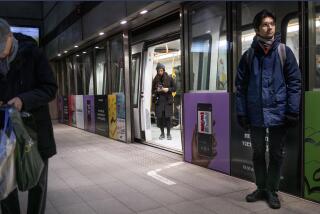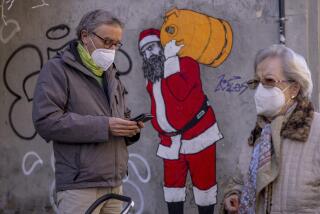Hard-hit Italy cautiously embraces new normal in coronavirus era
- Share via
ROME — With tourists still absent and office workers continuing to toil from home more than two months after Italy’s strict coronavirus lockdown ended, few were out and about on Rome’s central Via del Corso last week.
But in the Farmacrimi drug store, one product was being briskly traded.
“Masks keep on selling,” said manager Federica Faragali. “People buy them like cappuccinos.”
Among the places where face coverings are widely on display is the Circus Maximus, where socially distanced spectators — including women in gowns with matching masks — are back watching open-air performances of Verdi’s opera “Rigoletto.”
Five months after Italy was wracked by the West’s first major outbreak of the coronavirus, the nation continues to move cautiously toward a semblance of normality and has thus far not seen a major secondary flare-up of COVID-19 deaths.
New daily cases inched up on Friday to 552, but that was less than 1/10 of the 6,500 daily cases reported at the peak March 21 and 1/100 of the new cases in the U.S., where more than 50,000 are being reported each day.
New, minor clusters are being tackled across Italy, but no new shutdowns have been announced and the entire nation had a mere 42 patients in intensive care the other day. This in a country long stereotyped as anarchic and rule-breaking.
“When it came to lockdown and masks, we’ve been a lot less rebellious than you might think,” said Faragali.
The largely conscientious approach toward wearing masks and carefully sticking to rules on distancing and hygiene came as Italians took to heart the grim death toll that resulted when the coronavirus hit hard in late February. The nation, and world, watched in horror as army trucks were called in to remove coffins when cemeteries overflowed in Bergamo, the northern town at the epicenter of the outbreak, where hospitals were forced to make snap decisions on which patients got ventilators.
Antibody testing this month showed that 24% of Bergamo residents had come in contact with the virus, evidence of the swath it cut through the community.
“The impact of having our own Wuhan-type situation in Bergamo really brought it home,” said Fabrizio Pregliasco, a virologist at the University of Milan. “The army trucks, the virus hitting retirement homes — it really convinced Italians how serious it was.”
Fatalities in Italy have reached more than 35,000 — compared with more than 160,000 in the United States.
Since a 10-week lockdown ended in May, masks have been required in shops and all enclosed public spaces, with frequent temperature checks and hand sanitizer dispensers at entrances. Groups are banned in public when three-foot distancing cannot be guaranteed.
Nightclubs have reopened, but authorities demand that dancers remain six feet apart. Restaurants take the names of diners in case they need to be reached for contact tracing. Main line trains are running half-empty to allow adequate distancing.
A June survey found that 83% of Italians always wore a mask outside the home, compared with 54% of U.K. residents.
One reason Italians got in line was because they have a high regard for health and hygiene, said Walter Ricciardi, a virus expert and advisor to the nation’s health minister.
“Don’t forget the ancient Roman tradition for public baths and aqueducts,” he said. And “no one thought Italians would obey the smoking ban in public places in 2005 and they did.”
Italians have a life expectancy of 83.6 years, nearly five years more than that of Americans.
Italian microbiologist Andrea Crisanti has argued Italians have long lacked faith in the state taking care of their health needs, so they do so themselves.
Virologist Pregliasco takes the opposite view. “Italy has a strong public health system, which is good at passing on health information to Italians,” he said.
Either way, the tough line taken by Prime Minister Giuseppe Conte has so far resulted in strong approval ratings. Recently published minutes from government meetings in early March reveal that while scientific advisors suggested a full lockdown for northern Italy only, he decided to extend it nationwide.
“I believe now that prudence was justified,” Ricciardi said.
Precautions continue as the nation eases back into normalcy.
Since TV production company Lux Vide reopened its Rome studio in June, crew members have been tested once a week, and sprayed with disinfectant before walking out on the set. Drama production at Italian state TV network RAI is also back in full swing with actors regularly tested.
At the outdoor performances of “Rigoletto,” even those on stage stay six feet from each other.
On the long-running daily soap opera “Un Posto al Sole,” producers have decided not to refer to the virus in plot lines in the belief that viewers have had enough of it in real life.
“We needed lots of extras for a wedding scene and used the production staff, accountants and writers, knowing they had all been tested,” said RAI Fiction’s deputy editorial director Francesco Nardelli.
At the same time, a rise in new cases in recent summer days has some worried.
Experts warn that if the virus does make a comeback it may be the fault of Italians whose commitment to mask wearing appears to slip when they head to the beach. On the island of Lampedusa, where Sicilians have arrived in recent days for their holidays, masks were few and far between in cafes and restaurants.
Young Italians gathering at night in piazzas up and down the country have also been loath to mask up, even as the average age of new cases slips from 60-65 two months ago to 40, prompting an appeal from health minister Roberto Speranza.
“Be careful,” he told young Italians during a Senate address on Thursday. “You are the principal carrier of contagion now.
“The real risk is that you go home from a night out and infect your parents and grandparents.”
Some new cases have been linked to people entering Italy, including 244 migrants living in close proximity in a Treviso migrant center.
That has been seized on by anti-migrant opposition politician Matteo Salvini, who has warned that if a second wave arrives, foreigners will be to blame — even as he follows Donald Trump’s example and frowns on mask wearing.
“I am optimistic but prudent about Italy,” virologist Pregliasco said. “We need to watch the clusters and be vigilant but calm.”
More to Read
Sign up for Essential California
The most important California stories and recommendations in your inbox every morning.
You may occasionally receive promotional content from the Los Angeles Times.










